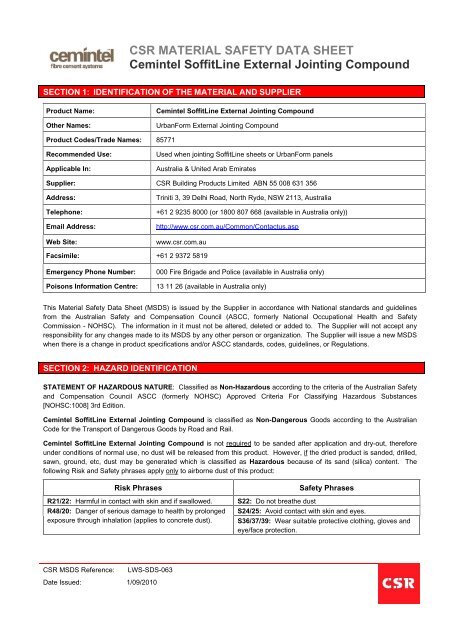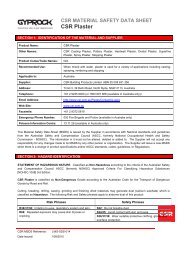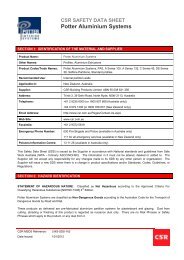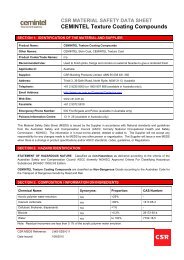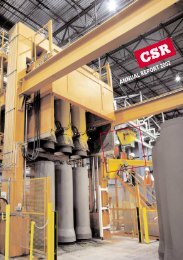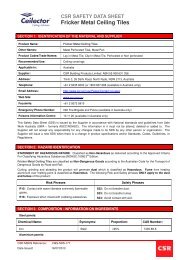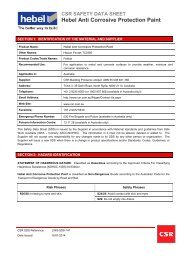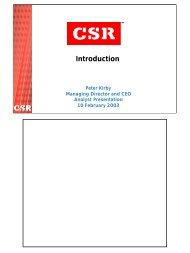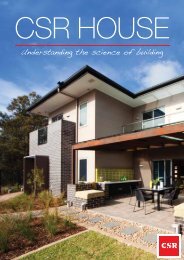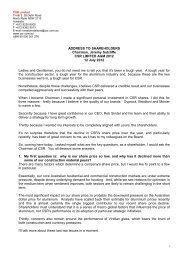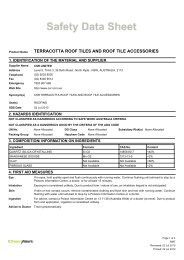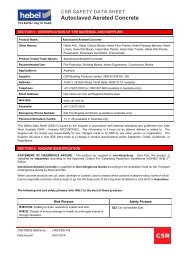CEMINTEL SoffitLine External Jointing Compound - CSR
CEMINTEL SoffitLine External Jointing Compound - CSR
CEMINTEL SoffitLine External Jointing Compound - CSR
Create successful ePaper yourself
Turn your PDF publications into a flip-book with our unique Google optimized e-Paper software.
<strong>CSR</strong> MATERIAL SAFETY DATA SHEET<br />
Cemintel <strong>SoffitLine</strong> <strong>External</strong> <strong>Jointing</strong> <strong>Compound</strong><br />
SECTION 1: IDENTIFICATION OF THE MATERIAL AND SUPPLIER<br />
Product Name:<br />
Other Names:<br />
Cemintel <strong>SoffitLine</strong> <strong>External</strong> <strong>Jointing</strong> <strong>Compound</strong><br />
UrbanForm <strong>External</strong> <strong>Jointing</strong> <strong>Compound</strong><br />
Product Codes/Trade Names: 85771<br />
Recommended Use:<br />
Applicable In:<br />
Used when jointing <strong>SoffitLine</strong> sheets or UrbanForm panels<br />
Australia & United Arab Emirates<br />
Supplier: <strong>CSR</strong> Building Products Limited ABN 55 008 631 356<br />
Address:<br />
Telephone:<br />
Email Address:<br />
Web Site:<br />
Triniti 3, 39 Delhi Road, North Ryde, NSW 2113, Australia<br />
+61 2 9235 8000 (or 1800 807 668 (available in Australia only))<br />
http://www.csr.com.au/Common/Contactus.asp<br />
www.csr.com.au<br />
Facsimile: +61 2 9372 5819<br />
Emergency Phone Number:<br />
Poisons Information Centre:<br />
000 Fire Brigade and Police (available in Australia only)<br />
13 11 26 (available in Australia only)<br />
This Material Safety Data Sheet (MSDS) is issued by the Supplier in accordance with National standards and guidelines<br />
from the Australian Safety and Compensation Council (ASCC, formerly National Occupational Health and Safety<br />
Commission - NOHSC). The information in it must not be altered, deleted or added to. The Supplier will not accept any<br />
responsibility for any changes made to its MSDS by any other person or organization. The Supplier will issue a new MSDS<br />
when there is a change in product specifications and/or ASCC standards, codes, guidelines, or Regulations.<br />
SECTION 2: HAZARD IDENTIFICATION<br />
STATEMENT OF HAZARDOUS NATURE: Classified as Non-Hazardous according to the criteria of the Australian Safety<br />
and Compensation Council ASCC (formerly NOHSC) Approved Criteria For Classifying Hazardous Substances<br />
[NOHSC:1008] 3rd Edition.<br />
Cemintel <strong>SoffitLine</strong> <strong>External</strong> <strong>Jointing</strong> <strong>Compound</strong> is classified as Non-Dangerous Goods according to the Australian<br />
Code for the Transport of Dangerous Goods by Road and Rail.<br />
Cemintel <strong>SoffitLine</strong> <strong>External</strong> <strong>Jointing</strong> <strong>Compound</strong> is not required to be sanded after application and dry-out, therefore<br />
under conditions of normal use, no dust will be released from this product. However, if the dried product is sanded, drilled,<br />
sawn, ground, etc, dust may be generated which is classified as Hazardous because of its sand (silica) content. The<br />
following Risk and Safety phrases apply only to airborne dust of this product:<br />
Risk Phrases<br />
R21/22: Harmful in contact with skin and if swallowed.<br />
R48/20: Danger of serious damage to health by prolonged<br />
exposure through inhalation (applies to concrete dust).<br />
Safety Phrases<br />
S22: Do not breathe dust<br />
S24/25: Avoid contact with skin and eyes.<br />
S36/37/39: Wear suitable protective clothing, gloves and<br />
eye/face protection.<br />
<strong>CSR</strong> MSDS Reference:<br />
LWS-SDS-063<br />
Date Issued: 1/09/2010
MSDS for Cemintel <strong>SoffitLine</strong> <strong>External</strong> <strong>Jointing</strong> <strong>Compound</strong><br />
SECTION 3: COMPOSITION / INFORMATION ON INGREDIENTS<br />
Page 2 o<br />
Chemical Name: Synonyms: Proportion: CAS Number:<br />
Crystalline silica (graded sand) Quartz 50-70% 14808-60-7<br />
Acrylic co-polymer dispersion n/a 20-50% ----<br />
Inorganic fillers n/a 5-20% ----<br />
Cellulosic thickener n/a 0-1% ----<br />
Propylene glycol n/a 1-3% 57-55-6<br />
Mineral oil based defoamer n/a 0-1% ----<br />
Anionic surfactant n/a 0-1% ----<br />
Preservatives (included in acrylic co-polymer) n/a 0.1% ----<br />
SECTION 4: FIRST AID MEASURES<br />
Swallowed:<br />
Eyes:<br />
Skin:<br />
Inhaled:<br />
Advice to Doctor:<br />
Do not induce vomiting. Give plenty of water to drink. Seek medical attention if any abdominal<br />
symptoms.<br />
Flush thoroughly with flowing water for at least 10 minutes. If eye contamination is more than<br />
minor, or if symptoms persist, seek medical attention.<br />
Wash thoroughly with soap and water. If irritation persists seek medical attention.<br />
Remove to fresh air. If irritation persists seek medical attention.<br />
Treat symptomatically.<br />
SECTION 5: FIRE FIGHTING MEASURES<br />
Flammability:<br />
Suitable extinguishing media:<br />
Hazards from combustion products:<br />
Special protective precautions and<br />
equipment for fire fighters:<br />
HAZCHEM Code:<br />
Non-flammable<br />
Use carbon dioxide, foam, dry chemical or water spray as required for fire in<br />
surrounding materials.<br />
When heated to decomposition it may emit carbon dioxide, acrid smoke and<br />
irritating fumes including acrylic monomers.<br />
As required for fire in surrounding materials.<br />
None<br />
SECTION 6: ACCIDENTAL RELEASE MEASURES<br />
Emergency Procedure:<br />
Containment Procedure:<br />
Clean Up Procedure:<br />
Clean up all spills immediately.· Wear protective equipment to prevent skin and<br />
eye contamination.<br />
Recover product wherever possible. Place spilled material in clean, dry, sealed<br />
container. Put residues in labelled containers for disposal. Prevent spillage<br />
from entering drains, sewers or water courses.<br />
Scrape/shovel material into bins. Flush spill area with water.<br />
<strong>CSR</strong> SDS Reference:<br />
LWS-SDS-063<br />
Date Issued: 1/09/2010
MSDS for Cemintel <strong>SoffitLine</strong> <strong>External</strong> <strong>Jointing</strong> <strong>Compound</strong><br />
SECTION 7: HANDLING AND STORAGE<br />
Page 3 o<br />
Handling:<br />
Storage:<br />
Incompatibilities:<br />
Manual handling should be in accordance with Manual Handling Regulations<br />
and Codes.<br />
Store in original containers. Check all containers are clearly labelled and free<br />
from leaks. Keep containers sealed when not in use. Store in a cool, dry, wellventilated<br />
area. Avoid contamination of water, foodstuffs, feed or seed.<br />
None<br />
SECTION 8: EXPOSURE CONTROLS / PERSONAL PROTECTION<br />
National Exposure Standards:<br />
National Occupational Health & Safety Commission (NOHSC)<br />
Australia Occupational Exposure Standard:<br />
None allocated specifically for this product.<br />
Under conditions of normal use, dust is not created or released. However, if the<br />
dried product is sanded, drilled, sawn, ground, etc, dust may be generated and<br />
the following applies:<br />
Crystalline silica (quartz): TWA - 0.1 mg/m 3 as respirable dust (≤ 7 microns<br />
particle equivalent aerodynamic diameter)<br />
Total dust (of any type, or particle size): TWA - 10 mg/m 3<br />
Notes on Exposure Standards:<br />
All occupational exposures to atmospheric contaminants should be kept to as<br />
low a level as is workable (practicable) and in all cases to below the National<br />
Standard.<br />
TWA (Time Weighted Average): the time-weighted average airborne<br />
concentration over an eight-hour working day, for a five-day working week over<br />
an entire working life. According to current knowledge this concentration should<br />
neither impair the health of, nor cause undue discomfort to, nearly all workers.<br />
Biological Limit Values:<br />
No biological limit allocated.<br />
ENGINEERING CONTROLS<br />
Ventilation: Mechanical exhaust ventilation not required where adequate natural ventilation<br />
available. Where dry dust is created, exhaust ventilation may be required to<br />
ensure exposure standards are not exceeded.<br />
<br />
Special Consideration for<br />
Repair &/or Maintenance of<br />
Contaminated Equipment:<br />
Work areas should be cleaned regularly by damp sweeping or vacuuming.<br />
Recommendations on Exposure Control and Personal Protection should be<br />
followed.<br />
PERSONAL PROTECTION<br />
Personal Hygiene Wash contaminated clothing and other protective equipment before storing or<br />
re-using. Wash hands before eating, drinking, using the toilet, or smoking.<br />
Skin Protection: Engineering controls and work practices should aim to minimise direct contact<br />
of skin. Direct skin contact should be avoided by wearing long sleeved shirts<br />
and long trousers, a cap or hat, and PVC gloves (AS 2161).<br />
Eye Protection: Safety spectacles with side shields or face shield or coverall goggles with direct<br />
ventilation (AS/NZS 1336) should be worn if a risk of eye contact exists.<br />
Respiratory Protection: Not usually required when using this product. If dust is generated from driedout<br />
product, an approved particulate respirator conforming to Australian<br />
Standards AS/NZS 1715 and 1716 should be worn, particularly if working in a<br />
work area without good natural ventilation. Respirators should be correctly<br />
<strong>CSR</strong> SDS Reference:<br />
LWS-SDS-063<br />
Date Issued: 1/09/2010
MSDS for Cemintel <strong>SoffitLine</strong> <strong>External</strong> <strong>Jointing</strong> <strong>Compound</strong><br />
Page 4 o<br />
fitted, maintained in good condition, and kept in clean storage when not in use.<br />
Replaceable filters and cartridges should be replaced regularly in accordance<br />
with the manufacturers’ guidelines.<br />
SECTION 9: PHYSICAL AND CHEMICAL PROPERTIES<br />
Appearance:<br />
Odour:<br />
pH, at stated concentration:<br />
Vapour Pressure:<br />
Vapour Density:<br />
Boiling Point/Range (°C):<br />
Freezing/Melting Point (°C):<br />
Solubility In Water:<br />
Specific Gravity (H 2 O = 1):<br />
White to off-white non-slump paste<br />
Mild<br />
Not available<br />
Not applicable<br />
Not applicable<br />
Not available<br />
Not available<br />
Immiscible<br />
Not available<br />
FLAMMABLE MATERIALS<br />
Flash Point: Not applicable<br />
Flash Point Method: Not applicable<br />
Flammable (Explosive) Limit -<br />
Upper:<br />
Flammable (Explosive) Limit -<br />
Lower:<br />
Not applicable<br />
Not applicable<br />
Autoignition Temperature: Not applicable<br />
ADDITIONAL PROPERTIES<br />
Evaporation Rate: Not available<br />
% Volatiles:
MSDS for Cemintel <strong>SoffitLine</strong> <strong>External</strong> <strong>Jointing</strong> <strong>Compound</strong><br />
Toxicology data: No direct data available for this or similar products. The following information is based on the toxicity<br />
profiles of a number of acrylic emulsions that are similar in composition to the acrylic polymer used in this product.<br />
Page 5 o<br />
Oral LD50 - rat: > 5000 mg/kg<br />
Dermal LD50 - rabbit: > 5000 mg/kg<br />
Skin irritation - rabbit: practically non-irritating<br />
Eye irritation - rabbit: inconsequential irritation<br />
Health Effects: Acute (short term)<br />
Swallowed:<br />
Unlikely under normal conditions of occupational use, but swallowing more than a mouthful of<br />
the compound may result in abdominal discomfort.<br />
Eyes:<br />
Skin:<br />
Inhaled:<br />
Splashes may irritate the eyes causing watering and redness.<br />
Skin contact with the wet product may result in slight irritation. Dust from the dry product,<br />
particularly in association with heat and sweat, may cause skin irritation.<br />
Unlikely under normal conditions of occupational use, but inhalation of dust from dried and<br />
machined product may irritate the nose and throat and respiratory system causing coughing and<br />
sneezing. Pre-existing upper respiratory and lung diseases including asthma and bronchitis<br />
may be aggravated.<br />
Health Effects: Chronic (long term)<br />
Eyes:<br />
Unlikely under normal conditions of occupational use, but dust may cause irritation and<br />
inflammation of the eyes and aggravate pre-existing eye conditions.<br />
Skin:<br />
Inhaled:<br />
Repeated skin contact in the occupational setting may lead to dermatitis.<br />
Unlikely under normal conditions of occupational use, but repeated exposure to the dust may<br />
result in increased nasal and respiratory secretions and coughing. Inflammation of lining tissue<br />
of the respiratory system may follow repeated exposure to high levels of dust with increased risk<br />
of bronchitis and pneumonia.<br />
Additional Notes<br />
Long Term Effects:<br />
Unlikely under normal conditions of occupational use of this product, but long-term overexposure<br />
or prolonged breathing-in (or inhalation) of crystalline silica dust at levels above the<br />
NES carries the risk of causing serious and irreversible lung disease, including bronchitis, and<br />
silicosis (scarring of the lung), including acute and/or accelerated silicosis. It may also increase<br />
the risk of other irreversible and serious disorders including scleroderma (a disease affecting<br />
the skin, joints, blood vessels and internal organs) and other auto-immune disorders.<br />
ASCC/NOHSC has not classified crystalline silica as a carcinogen.<br />
Special Toxic<br />
Effects:<br />
Inhalation of dust, including crystalline silica dust, is considered by medical authorities to<br />
increase the risk of lung disease due to tobacco smoking.<br />
SECTION 12: ECOLOGICAL INFORMATION<br />
Eco-toxicity:<br />
Persistence and<br />
Degradability:<br />
Mobility:<br />
The physical and chemical nature of the product and toxicological data on ingredients indicate<br />
that this product is of relatively low risk.<br />
Product is persistent and would have a low degradability.<br />
A low mobility would be expected in a landfill situation.<br />
SECTION 13: DISPOSAL CONSIDERATIONS<br />
<strong>CSR</strong> SDS Reference:<br />
LWS-SDS-063<br />
Date Issued: 1/09/2010
MSDS for Cemintel <strong>SoffitLine</strong> <strong>External</strong> <strong>Jointing</strong> <strong>Compound</strong><br />
Page 6 o<br />
Dispose of in accordance with local authority guidelines. Do not allow this product to enter drains, stormwater systems or<br />
waterways. Measures should be taken to prevent dust generation during disposal and exposure and personal precautions<br />
should be observed (see above).<br />
SECTION 14: TRANSPORT INFORMATION<br />
Proper Shipping<br />
Name:<br />
UN number:<br />
DG Class:<br />
Subsidiary Risk 1:<br />
Packaging Group:<br />
HAZCHEM code:<br />
Marine Pollutant:<br />
Special Precautions<br />
for User:<br />
None allocated<br />
None allocated<br />
None allocated<br />
None allocated<br />
None allocated<br />
None allocated<br />
No<br />
None<br />
SECTION 15: REGULATORY INFORMATION<br />
Poisons Schedule:<br />
Not scheduled<br />
SECTION 16: OTHER INFORMATION<br />
For further information on this product, please contact:<br />
<strong>CSR</strong> Building Products Limited (ABN 55 008 631 356), Triniti 3, 39 Delhi Road, North Ryde, NSW 2113, Australia.<br />
Phone:<br />
Fax:<br />
+61 2 9372 5888 or 1800 807 668 (available in Australia only)<br />
+61 2 9372 5877<br />
ADDITIONAL INFORMATION<br />
Australian Standards References:<br />
AS/NZS 1336<br />
Recommended Practices for Occupational Eye Protection<br />
AS/NZS 1715<br />
AS/NZS 1716<br />
AS 2161<br />
Selection, Use and Maintenance of Respiratory Protective Devices<br />
Respiratory Protective Devices<br />
Industrial Safety Gloves and Mittens (excluding electrical and medical gloves)<br />
Other References:<br />
NOHSC:2011(2003)<br />
NOHSC:10005(1999)<br />
NOHSC:2007(1994)<br />
NOHSC: 2012(1994)<br />
National Code of Practice for the Preparation of Material Safety Data Sheets 2nd Edition, April<br />
2003, National Occupational Health and Safety Commission.<br />
List Of Designated Hazardous Substances, April 1999, National Occupational Health and<br />
Safety Commission, Sydney.<br />
National Code of Practice for the Control of Workplace Hazardous Substances (Australian<br />
States have similar Codes of Practice in each State).<br />
National Code of Practice for the Labelling of Workplace Substances, March 1994, Australian<br />
<strong>CSR</strong> SDS Reference:<br />
LWS-SDS-063<br />
Date Issued: 1/09/2010
MSDS for Cemintel <strong>SoffitLine</strong> <strong>External</strong> <strong>Jointing</strong> <strong>Compound</strong><br />
Page 7 o<br />
Government Publishing Service, Canberra.<br />
NES<br />
ADG Code 6 th Edition<br />
National Occupational Exposure Standards for workplace Atmospheric Contaminants (NES)<br />
Australian Safety and Compensation Council, ASCC (Formerly NOHSC) 1995 as amended.<br />
Australian Dangerous Goods Code 6 th Edition.<br />
AUTHORISATION<br />
Reason for Issue: New Address<br />
Authorised by: Ben Thompson<br />
Date of Issue: 1/09/2010<br />
Whilst the information contained in this document is based on data which, to the best of our knowledge, was accurate and<br />
reliable at the time of preparation, no responsibility can be accepted by us for errors and omissions. The provision of this<br />
information should not be construed as a recommendation to use any of our products in violation of any patent rights or in<br />
breach of any statute or regulation. Users are advised to make their own determination as to the suitability of this<br />
information in relation to their particular purposes and specific circumstances. Since the information contained in this<br />
document may be applied under conditions beyond our control, no responsibility can be accepted by us for any loss or<br />
damage caused by any person acting or refraining from action as a result of this information.<br />
END OF MSDS<br />
<strong>CSR</strong> SDS Reference:<br />
LWS-SDS-063<br />
Date Issued: 1/09/2010


